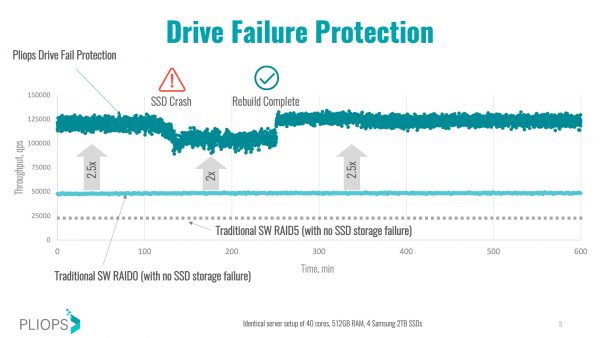Throughout this series, we have covered a thorough introduction to Pliops and their Pliops Storage Processor (PSP), as well as the challenges that they are solving in the data center. There are 4 main areas in which the Pliops solution aims to improve for SSD storage: Acceleration, Increased Capacity, Data Protection, and Endurance.
In our last piece, we dived into how Pliops achieves greater acceleration using their hardware key-value engine to provide up to 10x faster operations with up to 80% reduction in latency, as well as how Pliops can increase the usable capacity of your SSD and reduce your $/GB by up to 75%.
In this post, let’s focus on the last two categories of the Pliops solution: Data Protection and Endurance. These are two very important pieces of the puzzle to building reliable, high-performance database applications. Performance and response time are always what database users are concerned about. Pliops aims to deliver data protection around drive failures while increasing the endurance of SSDs.
Surviving Drive Failure
Having built their own architecture around data protection called Drive Fail Protection, Pliops have designed their PSP to be able to survive multiple single drive failures while continuing to provide access and performance while the data rebuilds on the remaining drives. As the PSP is aware of the structure of the data due to its indexing capabilities, the rebuild process is much faster than a RAID 5 or 6 rebuild as there is no requirement to rebuild the full capacity of the drive. There is likely to be 10-15% degradation, however, it is unlikely the end-users would see the drop in performance as the PSP will continue to provide accelerated performance 2x that of RAID 0 or RAID 5.
It may appear on the surface that the drives are in a RAID 5 or 6 group, but there are reasons why Pliops have built their data protection from the ground up. When working with RAID 5 or 6, there is an increase in random write workloads due to read-modify writes that will both increase write amplification on the SSD cells, as well as severely impact performance. Pliops believes that your databases need to continue to perform at their peak and that losing a drive should not impact that performance or decrease the life of the new drive during the rebuild.

Going the Distance with Pliops
Mechanical hard drives have had the same challenges ever since their inception, they are mechanical and have moving parts that can break down and wear out over time, especially at the speed that those parts move at. While SSDs don’t have any mechanical components to worry about, they do suffer from write amplification caused by certain operations, such as garbage collection, random writes, and wear leveling. When working with databases or any other application that is storage heavy, the write amplification is increased significantly and the lifetime of the SSD is decreased.
NAND flash endurance is categorized under three different metrics using Drive Writes Per Day (DWPD), Terabytes Written (TBW), and GB Written Per Day (GB/day). These metrics allow the user to understand the expected life of the drive.
Newer, dense SSD technology such as QLC NAND flash push to pack more bits onto each cell of the drive, this gives the benefit of larger capacity drives for less, but also introduces the disadvantage of lower endurance, especially with write-heavy workloads. Each cell holds more bits allowing for more times that a write can be made to that cell.
Pliops decreases the write amplification by optimizing compression, packing, and garbage collection processes and by eliminating random writes made to the drive. The PSP removes certain operations from being performed directly on the drive to prevent write amplification and will perform the tasks through itself to ensure that the data is optimally written to the drive.
Pliops Storage Processor

Pliops has certainly put a great deal of effort into the Pliops Storage Processor. This is a great piece of technology helping companies to be able to use low-cost SSDs in their enterprise environment and get added performance, increased capacity, data protection, and prolonged drive reliability.
By implementing a Pliops Storage Processor, you are removing additional costs that would otherwise be utilized to purchase additional drives and servers to improve your performance and capacity while also freeing up memory and computer resources. This also allows you to be able to run more applications and lower your overall server footprint. Pliops is continuing to improve and expand the capabilities of the PSP and hopes to be able to support hypervisors and more operating systems in the near future.
To find out more about Pliops and their GA launch date, head over to their website where you will find whitepapers, calculators, and solution briefs. You can also check out their most recent Storage Field Day appearance for more information.




